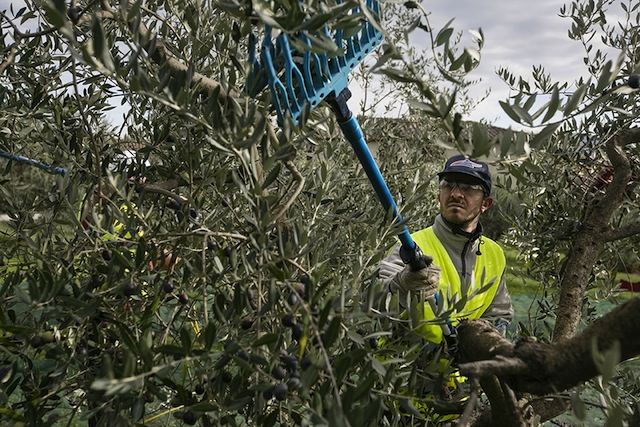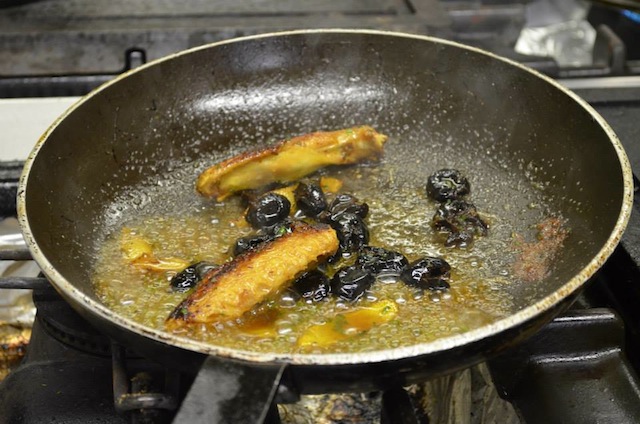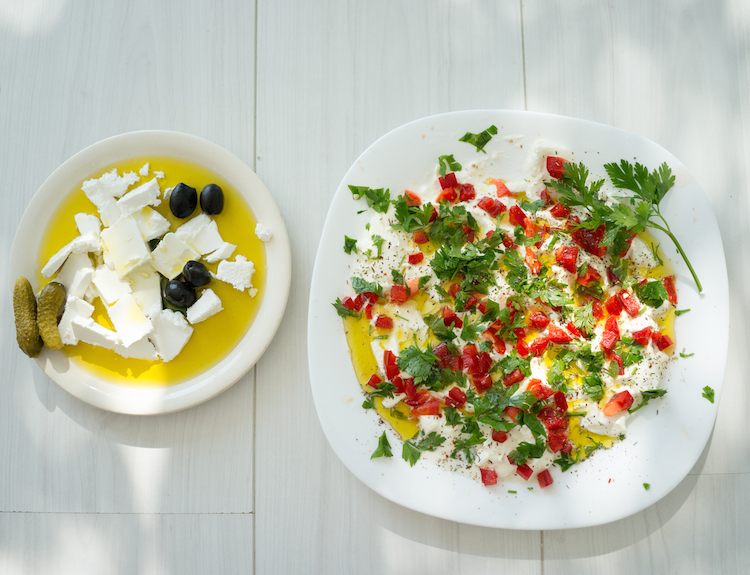
By Epicure & Culture
Olive oil is a super ingredient with the ability to enhance the flavors of a dish while also adding antioxidants and heart-healthy benefits. That being said, there are many misconceptions that exist on the product. That’s why — with the help of agronomist Marco Soldani of Castelfalfi and agronomist Francesco Caselli of Castello di Gabbiano — we’re debunking some of olive oils most common misconceptions. Use the following facts to help you choose a top-of-the-line olive oil:
Tip: The best way to understand olive oil harvesting and production methods — and to taste some for yourself — is to visit a working olive oil mill. During a recent trip to Tuscany, I was able to visit the production spaces as well as enjoy cooking classes incorporating the ingredient at both Castello di Gabbiano and Castelfalfi. These are both highly recommended experiences that will leave you more enlightened on the topic of olive oil and Tuscan culture.

1. You Can Cook With Extra Virgin Olive Oil
One common misconception when talking about olive oil is that you can’t cook with it. The truth it, extra virgin olive oil is used for both tossing vegetables and frying them.
“Traditionally, extra virgin olive oil was the only oil used to fry, because it is the best oil to do it,” explains Soldani. “It has a high melting point and is rich in Omega-3.”
Castello di Gabbiano’s Francesco Caselli adds, “Extra virgin olive oil contains more aromatic compounds that help to enhance the flavor of the dishes. The extra virgin olive oil is the most healthy fat, and it is very versatile as it can be used be used in both raw and cooked food. It also has the higher degree of resistance to degradation of the heat, which means frying does not produce toxic substances.”
The only reason one might not want to cook with extra virgin olive oil is because there are cheaper oil options one can use for frying — like vegetable oil and canola oil — with the olive oil being saving as a topping for full flavor.

2. Not All Extra Virgin Olive Oils Are Created Equal
Many consumers purchase olive oil without really knowing what they’re buying, when in fact there exist many different qualities of olive oil. The highest quality of olive oil is extra virgin olive oil.
By definition, extra virgin olive oil must meet very restrictive requirements, which, according to Caselli, includes being extracted at a lower temperature of 27°C (81°F) and within 24 hours from picking. The oil must be obtained by mechanical cold pressing — without the addition of solvents — during the first pressing of the olives and bottled immediately.
An olive oil produced after the first mechanical extraction undergoes further physico-chemical treatments, causing it to lose quality. This means, if you buy an olive oil of a lower quality than extra virgin your product may be low in Vitamin E and antioxidants, can have a higher acidity (up to 2%, even when buying virgin olive oil made through the same process), and may even cause digestive issues.
That being said, some olive oil producers offer a higher label to distinguish an even more valuable type of extra virgin olive oil. For example, Castelfalfi offers a premium label, which means the olives were pressed during the first 12 hours after being picked. Because the time span between picking and pressing the olives directly correlates to the quality of the oil, this leads to an extremely high quality product.
Note that it’s important to talk to the producer directly to ensure you know exactly what you’re buying, and that you’re purchasing their best available product. In Tuscany, a further guarantee of high quality is the D.O.P. appellation — a European appellation — whose regulation is even stricter, for example, acidity cannot exceed 0.5%. For D.O.P. Chianti Classico Extra Virgin Olive Oil, the law states: “the extraction of the oil “Chianti Classico” must be effected after washing olives with room temperature water, by mechanical continuous process; extraction plant temperature must be controlled and must not exceed the 27°C (80.6°F).

3. Pure Olive Oil Isn’t Really Pure
A grade below extra virgin olive oil is virgin olive oil, made through the same process as extra virgin but with riper olives. Below that, you get pure olive oil, which is frankly a very misleading name. Pure olive oil refers to a blend of refined and virgin olive oils, meaning you’re getting a lower quality olive oil with many of the antioxidants potentially missing. For this reason, if you buy pure olive oil it’s best to use it for frying, not dressing salads or dipping breads.

4. Low Acidity Is Important When It Comes To Olive Oil
Going off of the previous statement, when choosing an olive oil you want to make sure it has a low acidity. A low acidity is associated with a higher quality, which leads to a more pleasant taste. Moreover, a low acidity typically means the producer pressed the olives shortly after picking, which is crucial for high quality olive oil.

5. Not All Olive Oil Comes From Italy
While it’s true Italy produces some of the highest quality olive oil in the world — not to mention it’s the highest exporter of the product — there are other countries/regions also making the product in a delicious way. Some of these include Spain, California, Turkey, Greece, Portugal and Morocco.
6. It’s Much More Than Squeezing Oil From The Fruit
According to Caselli, all production begins by transforming the olive fruit into olive paste by crushing or pressing. This paste is then malaxed (slowly churned or mixed) to allow the microscopic oil droplets to agglomerate. The oil is then separated from the watery matter and fruit pulp with the use of a press (traditional method) or centrifugation (modern method).
“At Castello di Gabbiano we use centrigufation,” he explains. “It gives a higher guarantee of avoiding heating of the product during extraction.”

7. Light Destroys Olive Oil
Have you ever wondered why olive oil typically comes in a dark green bottle? It’s because light destroys olive oil through oxidation, changing the beneficial chemical compounds and exchanging antioxidants for free radicals. Keep olive oil out of the light, and make sure you only buy the product in a dark bottle. That being said, the refrigerator is also not a great place for it, as condensation can dilute and spoil the oil. A room-temperature cabinet is the best place.

8. Vintage Is A Term Used For Both Wines And Olive Oil
While vintage is a term used for both wines and olive oil, there is a big difference: Olive oil does not get better with age.
“The aging process begins right after it’s been pressed,” explains Caselli. “The olive oil changes immediately from the organoleptic point of view and its color in the first 4-8 weeks of its life.”
While by law, producers must state on the label a two year-expiration date, it gets confusing because it will also say the product does not degrade, and that although it will be less tasty when it is older, it is still a good product for cooking. When purchasing olive oil, you want the youngest possible product, which you should use up in a timely manner.

9. Only A Small Portion Of The Olive Gets Used For Oil
When making olive oil, only 10 percent of the olive goes into the product, with the other 90 percent, being waste, that typically gets added to fertilizer. To understand these numbers, it’s important to look at how the olive press works. The machine first presses the olives, reducing them to a paste. From there, the solids are separated from the liquid, which is then centrifuged or pressed to separate the water from the oil.

10. Cold Extraction Is Great For Flavor
Cold extraction is a term that gets thrown around quite a bit, although many are still confused about what it is and why an olive oil producer would employ it. The term refers to a particular extraction technique where the temperature remains under 80 °F (27 °C) during the pressing process. This is done so the flavor and aroma of the olive oil doesn’t change, as higher temperatures can potentially degrade its components earlier.
According to Caselli, most production of extra virgin olive oil is made by a cold process for the above-mentioned reasons. High temperatures may make the extraction easier — which means some producers will go this route — but does not guarantee to keep original quality characteristics of the oil.

11. You Can’t Judge By The Label If It’s Good Olive Oil
While there is a lot of information on a bottle of olive oil, it’s impossible to know just from that whether it’s a good product or not. To be sure, you’ll either need to taste the olive oil yourself or contact the producer to ask about their techniques for production.
The quicker the olives were pressed after being picked, the better. If a label lists numerous countries, there’s a good chance the olives were picked somewhere other than where they were packaged, meaning a lower quality. Ask when the harvest date was, if it contains additives, and where exactly it was harvested and bottled.
Remember, buying a good olive oil is important for getting both the flavor and health benefits its known for (or why else would you be buying it in the first place?).

12. Your Extra Virgin Olive Oil May Not Actually Be Extra Virgin
It’s sad to say, but low quality oils are something manipulated using food coloring and sold as extra virgin, meaning you lose the health and beauty benefits as well as the great taste.
“It is not easy to be sure about the quality of olive oil,” explains Soldani. “Usually consumers are protected by the laws they can find written on the label, but olive oil doesn’t have the strict legislation that wine does.”
So how can you protect yourself from misleading olive oil labels? Soldani recommends getting in touch directly with the olive oil producer. If possible, one should buy straight from the farm, especially since visiting a mill that producers olive oil allows you to see firsthand exactly what you’re getting. In Tuscany, both Castello di Gabbiano and Castelfalfi offer an olive harvesting and pressing experience during the season, which runs from the end of October until the end of December, as to be extra virgin olive oil the olives must be picked by December 31.

13. That Olive Oil From Italy May Not Be Italian
Again, this is why you can’t just judge an olive oil by its label; you need to taste it and talk to the producer. Many olive oil makers will have their product packaged or bottled in Italy just to get the Italy seal to mislead consumers. The truth is, the actual production of the olive oil could have taken place in another country, which also means it’s less fresh.

14. Olive Oil Is Essentially A Fruit Juice
Olives are fruit, and olive oil is that fruit’s juice. Juice is never better than when it’s fresh squeezed and drank right after production. The same goes for olive oil. Keep this in mind when looking for your perfect olive oil.
ABOUT EPICURE & CULTURE
This article was originally published on Epicure & Culture, an online food, culture and responsible tourism magazine. With a focus on immersive, transformative and ethical experiences, the goal of the publication is to help people explore the world in a positive and life-changing way. Along with visiting their website, you can follow them on Facebook, Twitter and Instagram.
Featured image Italian meal with olive oil via Shutterstock





